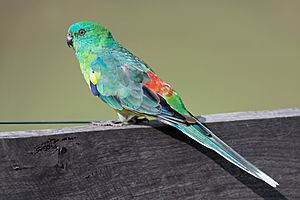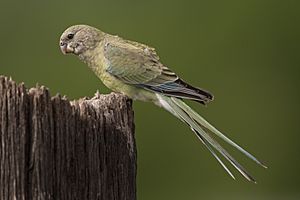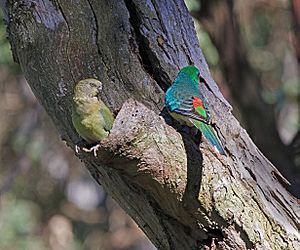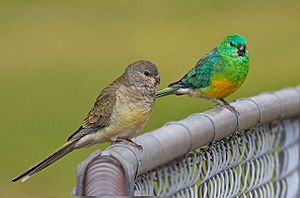Red-rumped parrot facts for kids
Quick facts for kids Red-rumped parrot |
|
|---|---|
 |
|
| Male in New South Wales, Australia | |
 |
|
| Female in New South Wales, Australia | |
| Conservation status | |
| Scientific classification | |
| Genus: |
Psephotus
|
| Species: |
haematonotus
|
| Subspecies | |
|
P. h. caeruleus |
|
The red-rumped parrot (Psephotus haematonotus) is a colorful bird found in south-eastern Australia. It's also known as the red-backed parrot or grass parrot. You'll often see these birds in the Murray-Darling Basin, a large river system in Australia.
Contents
About the Red-Rumped Parrot Name
The red-rumped parrot was first described in 1838 by a scientist named John Gould. He gave it the scientific name Platycercus haematonotus. The name "haematonotus" comes from Greek words meaning "blood-red back," which describes the male bird's red rump.
This parrot is the only species left in its group, called the genus Psephotus. Other similar parrots were moved to a new group called Psephotellus. The official common name for this bird is the red-rumped parrot. People also call it the red-backed parrot or grass parrot.
What Does a Red-Rumped Parrot Look Like?
Red-rumped parrots are slim, medium-sized parrots. They are about 28 centimeters (11 inches) long.
The male parrot is very bright. It has emerald-green feathers with yellow underneath. Its lower back, or "rump," is a bright brick-red color. It also has pretty blue highlights on its wings and upper back.
The female parrot is not as colorful. She has pale olive-green feathers underneath. Her wings and back are a duller green. Her wingtips are blue-black. Only the male has the bright red rump.
Red-Rumped Parrot Behavior and Habitat
You can find red-rumped parrots in pairs or in groups. They like open areas where they can easily find water. They usually stay away from the coast and very dense forests.
These birds often feed on the ground. Their green feathers help them blend in with the grass. This makes them very hard to spot until you are quite close. They often call to each other with a sound like "chee chillip chee chillip."
Over time, people have cleared many forests and provided water for farm animals. This has likely helped the red-rumped parrot spread to new areas. You might even see them in parks and gardens in towns.
Red-Rumped Parrot Reproduction
Like many parrots, red-rumped parrots build their nests in hollows inside trees. They might also use hollow fenceposts or tree stumps.
A female parrot usually lays 3 to 6 white eggs. Breeding often happens in spring, from August to January. However, in drier parts of Australia, they can breed at any time of year, especially after it rains.
Red-Rumped Parrots as Pets
Red-rumped parrots are quite easy to breed if they are kept as pets. They need enough space to fly and a large nesting box. Breeders often use peat and wood shavings for the nest bedding. The birds like to arrange their nests just how they like them.
After mating, the female parrot will lay 4 to 7 eggs. She will sit on the eggs for about 20 days to keep them warm. She is very dedicated and will not leave her eggs, even if a person checks on them. The baby birds will hatch around 30 days later. It's important to remove the young birds once they can fly. This is because the male parent might try to attack his own babies. Parrots can start breeding when they are about one year old. The male parrot will feed the female while she is sitting on the eggs.
Some red-rumped parrots have different feather colors because of special breeding. For example, you can easily find yellow red-rumped parrots.
Housing Your Red-Rumped Parrot
Red-rumped parrots do well in large cages or aviaries. They don't like to be in crowded spaces. If they don't have enough room, they might become aggressive towards other birds.
You can also hand-raise red-rumped parrots. If you do, make sure they have a big cage. It's also important to take them out of their cage every day. This helps prevent them from getting bored. If they get too bored, they might start pulling out their own feathers.
How Long Do Red-Rumped Parrots Live?
If red-rumped parrots are cared for properly in captivity, they can live for a long time. They can live anywhere from 15 to 32 years.
See also
 In Spanish: Perico dorsirrojo para niños
In Spanish: Perico dorsirrojo para niños




